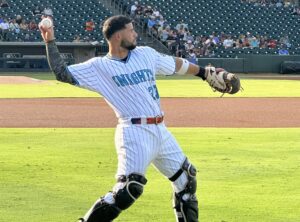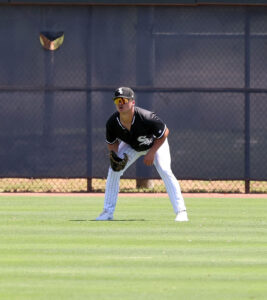Bristol Sox visit wrapup – interview with the manager and final thoughts
For one more piece on the 2013 Bristol White Sox, I was privileged to get a chance to meet with Bristol Sox manager Mike Gellinger. (He’s the one leaning against the fence)

From my perspective this was a real treat, because Mr. Gellinger is a former assistant hitting coach with the big league club. He’s thrown batting practice to Frank Thomas in home run derbies and he has himself an 05 world series ring. So, I got to shake the hand of a guy who has an 05 ring and thank him for that.
One of the first things I wanted to ask him about was a peculiar role he filled for the White Sox, he was listed as Computer Scouting Analyst starting in 1997 and held that role during the time of the “moneyball” revolution.
From his perspective, he believes he saw the league’s philosophy changed significantly while he was in the role but the White Sox were impressively out front. He said of the Sox “Us and the Cleveland Indians were really the first 2 teams to use computer scouting information, we used a program called “BATS” which now 28 out of 30 teams use and nobody used it before. We were using it in 1990 I think, charting games on paper, inputting them into the computer and gathering information long before most teams were doing it. After that 05 season, it was more about 07 when it seemed like everyone started jumping on it, because then it turned into not just a data source but also a video source where you could chart pitches, put the stuff in the zone, click on it, and it would show you the actual image of the guy hitting. Pretty neat stuff now”.
I asked Manager Gellinger to highlight a guy or two from his team for me. The first name that popped up was Toby Thomas. I saved some videos specifically for this article:
Toby played shortstop for them and hit .319 on the season as a 19 year old. Mr. Gellinger says he can play short, second, and third, “does a nice job, he’s hit the ball really well this year, he’s definitely a player that i think can go a long way in this organization”. Obviously a lot of things have to be said and done, he has to continue to grow and progress, but “he shows a lot of promise”.
That was an interesting guy to highlight given that the White Sox org has had some success in developing guys who can play multiple IF positions and do a decent job over the past few years, from Getz to Semien to Escobar to Johnson. Toby Thomas might be a guy we can talk about on that list in a year or two. He’s a righty and as I said in my first Bristol Sox post, that park has to kill power for righties, but even with that his slugging numbers are pretty good.
Second thing I asked about was pitching. He immediately highlighted “Tyler Danish” who had just moved up at the time. One of the more interesting things I learned about their plans for Danish from asking around was that they actually had him on a starters throwing schedule even though he was only working out of the bullpen; he was getting game action only every 5th day and then throwing again on the 2nd day, the usual schedule for starters. Clearly they wanted to keep his innings under control but definitely wanted him to get used to the rhythm of being a starting pitcher as well.
He also highlighted Lowry and Michalczewski as other guys to keep an eye on.
I asked about that night’s starting pitcher, Kelvis Valerio, one of the guys out of the DSL and the guy who had led his team in innings. Mr. Gellinger said of him “he can pitch. He’s not going to overpower anybody, he’s not going to dominate anybody, he’s going to have to pitch, he’s going to have to locate, he’s going to have to throw his offspeed stuff for strikes, but he does a pretty good job of that. He’s a good pitcher and that’s what he is”.
One thing I just had to ask him about was his experience as a big league hitting coach, who he’d wound up helping the most. The answer that popped immediately out of his mouth was Konerko. I know we’ve all heard Hawk Harrelson joke about how hard Konerko would take bad games early in his career; Gellinger backed him up on that, saying that even if he had a 1/4 game, if he felt like he missed a pitch he’d wind up really down. He also described how studious, how in-tune he was with hitting, how a guy would throw a 95 mph fastball to Konerko and he’d come back to the dugout and tell you how his right foot felt or something like that.
Some final wrap-up words from this visit. I really wanted to get the feel for what the organization was trying to teach these guys, and I think at this level, it seemed to be more “getting the feel of pro ball” more than anything. I highlighted above how they were just trying to get guys like Danish to have the feel of pro ball and to get the rhythm, that permeated a lot at this level.
A good example is Zapata. I didn’t get to see recent signee Micker Zapata while he was here (I was a couple weeks late) but did ask people about him. They had Zapata with them for a couple weeks, not on the roster but taking BP. They had him along for the ride more than anything because they wanted him to see the routine of minor league ball, taking batting practice, doing the workouts, seeing how things went, traveling with the team, etc. so that he was set up for the next year when hopefully he starts with one of these affiliates. No idea where yet, but that was their main goal in Bristol; getting him acclimated.
They also described him killing the ball out of that park, and like I keep saying, for a righty that’s a big ballpark. He’s hitting the ball out of that park and he’s killing the ball.
A couple of the guys on the roster have family members who were big leaguers and they also described that as helping them get used to the routine. Nolan Earley has a brother higher-up in the Sox org (Michael Earley) and names like Patrick Palmeiro, Cody Yount, and (recently-suspended) Nick Parent also could fill those roles of having seen big-league professional clubhouses. For both the recent draftees and the DSL guys having the presence of people who have been in professional clubhouses before or who have family members who had been in those clubhouses seemed to be a big deal and several guys mentioned that.
They didn’t want to overwhelm guys too much, either hitting or pitching. Command your fastball, be balanced at the plate, play hard, practice your fundamentals, and get your work in.
Thanks again to all the guys in Bristol for letting me take their time and indulging Futuresox in this. I think I got some real insight into this organization and how it brings people along, I hope you have as well.
-Balta






